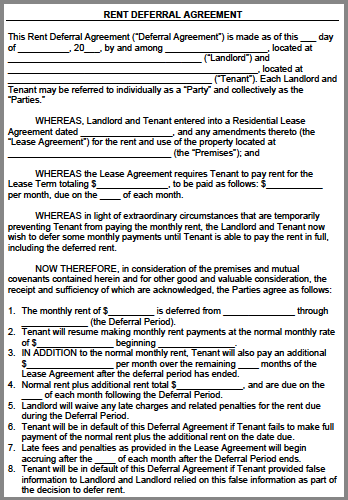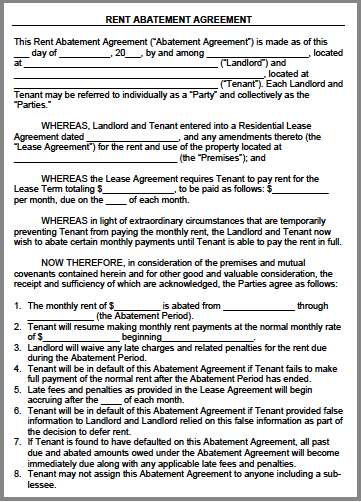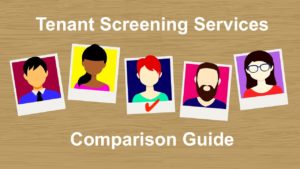Bad things happen to good tenants and they need rent relief sometimes. Like when a tenant loses their job through no fault of their own. Normally I don’t advocate for allowing late rent but the coronavirus pandemic makes this very unusual times. It got me thinking. What would I do if one of my tenant’s couldn’t pay the rent because of something outside their control?
I’m not sure exactly but I know I would evaluate it case-by-case. Given that we are likely already in a recession at least as bad as the Great Recession, I wanted to offer my readers some guidance.
Some of you may be facing this situation right now and are wondering if you should offer a discount or even forego rent for a while. You may be thinking that you want to do the right thing but also want to make sure you protect yourself by not setting a bad precedent and giving up your own rights as a landlord.
So I decided to develop some forms you can modify if you need to temporarily provide struggling tenant with rent relief.
Specifically, I will:
- Show you my criteria to decide if I should offer rent relief
- Review your 3 options of rent relief you can provide
- Give you with sample forms you can use
But first, I want to discuss how to handle a request from your tenant.
How To Handle A Rent Relief Request
First of all, I want to be clear. Providing a tenant with temporary or permanent rent relief should be considered on a case-by-case basis. It should be the exception to a strict zero-tolerance policy of not accepting late rent. It should only be allowed under extra-ordinary circumstances – such as the one we are currently in right now.
This is because you don’t want to set a precedent that can be used against you later in court. In strict states your past allowances can actually create a new agreement that you didn’t intend to get into. Be careful.
You should also be careful to apply the same logic and policy to everyone’s circumstances. Otherwise you risk being accused of discrimination. Allowing one tenant to forego rent or waive late fees but not another can be misconstrued as a form of discrimination if the one tenant is a member of a protected class. Always apply the same logic to each case.
Here’s an example of my criteria checklist that I created. You can use or modify it to suit your needs:
- Unusual Circumstances – Tenant’s need must arise from a highly unusual situation (e.g., Global pandemic shuts down virtually all economic activity).
- No Fault of Tenant – Tenant’s hardship can’t be self-inflicted. For example, the tenant quitting their job is not a good reason that they need rent relief. If the tenant was laid off from work and this was unforeseeable then this is an example of a no-fault situation.
- Model Tenant – This must be the tenant’s first rent-related or other lease violation issue. They must have otherwise been model tenants.
- Tenant Will Recover – I can foresee the tenant coming through this situation and returning to normal finances in the near term.
Finally, you should take care to be empathetic to your tenant’s situation but avoid getting emotionally attached. You want to hear them out and work with them but do not make their problems your own.
Generally, if they are facing an unforeseen hardship through no fault of their own, and this is their first such request, then you should make every accommodation possible. This is especially true for great tenants that you want to keep for the long run.
Being fair is good business. Helping good tenants get back on their feet will save you in turnover costs and ultimately help you build a reputation as a landlord that everyone will want to rent from.
Rent Relief Option 1 – Deferred Rent
Your first option when dealing with a tenant who cannot pay the rent is to defer their rent temporarily. When you defer rent, you suspend the rent due and amortize (evenly spread out) the unpaid rent over the remaining months once payments are required to be made again.
Let’s say you have a tenant who has 9 months left on a 12-month lease. They come to you with a request to help them out until they can get back on their feet two months from now when their new job starts or unemployment kicks in.
Assuming their monthly rent is $1,800, you can offer to defer the next two month’s rent. They will then have to pay you the $3,600 defered rent over the remaining 7 months. In this case that amounts to an extra $514.29 ($1,800 x 2 = $3,600 ÷ 7).
This is a good option for you as a landlord because it only defers your receipt of the full lease value.
However, there are two downsides.
The first downside is that your tenant may not be able to pay you back the extra rent over the remainder of the lease. That’s because many renters are already paying close to 1/3 of their income in rent. In the example above the extra $514 pushes this monthly rent cost to about 43%. This may be too high of a burden for some renters and my force them to default again later.
The second downside is for you the landlord. Many landlords don’t carry adequate reserves to cover their expenses for too long. However, if you carry enough reserves (Landlord Tip #2), this won’t be an issue for you.
Rent Relief Option 2 – Temporary Rent Reduction
It may seem counterintuitive but it might make better financial sense to temporarily reduce your tenant’s rent obligation. Evicting a tenant, turning over your unit, and finding a new tenant will cost thousands of dollars.
If you believe this is just a temporary setback for your tenant, then you might save thousands of dollars by giving up hundreds in rental income.
To put this in perspective let’s look at the following scenario:
Your tenant has just lost their job and has asked you for a break on the rent just until they can get back on their feet again. You believe they are well qualified and will find a job in the next 2-3 months.
Rent is $1,800 per month and they have 9 months left on the current lease.
Instead of evicting them after they can no longer pay, you offer to reduce their rent by 1/3 for 3 months or until they get another job, whichever happens first.
$1,800 = Maximum cost of temporary rent reduction
Versus
$6,000 = Potential cost to evict and turnover unit
It may be a good financial decision to reduce rent when you compare that cost against the potential cost of evicting them ($3,500) and turnover expenses ($2,500).
In addition to the financial benefit, you will also build a reputation as a great landlord, which will potentially help you realize lower vacancies and marketing costs in the future.
Drawbacks
The major risk here is that you delay the inevitable. If your tenant cannot recover and you ultimately need to evict, then you will come out worse off than had you initially evicted them.
That’s where the rent relief decision criteria come into play. You need to be reasonably certain they will recover financially.
Rent Relief Option 3 – Temporary Rent Abatement
Rent abatement is when a landlord temporarily suspends rent payments and forgives the amount owed. Most landlords don’t have enough reserves to forgive rent for an extended period of time. However, in some extreme instances it may make more sense to forgive a month or two of rent in order to avoid the cost, hassle, and uncertainty of an eviction.
Here are some things to keep in mind if you decide to forgive rent for a tenant.
Avoid Ambiguity
Do not rely on a verbal agreement or a text exchange. If you agree to forgive your tenant’s rent, be sure to document it in a formal agreement like the example I provide below.
Spell out which rent periods are forgiven and when normal rent resumes again. Be sure to specify that all other lease terms remain in effect during the abatement period. You should also specify that late fees will begin accruing once the rent abatement period is over.
Include a statement indicating you will pursue eviction if they fail to resume payments as agreed.
Documentation
You should collect documentation to support the tenant’s claim they need rent relief. Are their work hours being reduced or have they been laid off? A letter from their employer would suffice. Are they unable to work because of local shelter in place order and they are deemed unessential workers? This should be readily apparent. Either way, require them to certify that their statements are true.
Confidentiality
You generally don’t want your tenant broadcasting that you forgave their rent to other tenants. Your decision to provide rent relief is based on their particular case. Include a statement that they cannot disclose the terms of their agreement with anyone else.
Not Assignable
The relief you provide to your tenant is for them only. They cannot assign that relief or profit from it by subletting the apartment.
You Can’t Ask For the Rent Later
This should be obvious but once you agree to forgive the rent, you can’t go back later and ask them to repay. Your tenant is no longer obligated to pay you for the rent you forgave. This is only true if they fulfill the requirements of your new agreement.
Clawbacks
Be sure to include a clawback provision. If your tenant fails to resume normal rent payments once the forgiveness period is over, you want to be able to go after them for the rent you forgave.
Tax Implications
A lease is a form of debt. If you forgive a portion your tenant’s rent then it is taxable income to them. You are obligated to file a 1099-C with the IRS if your forgive $600 or more. You should also notify your tenant of this requirement.
Eviction – The Last Resort
While you want to do everything you can to retain good tenants and help them during difficult times it may not always be feasible. Eviction is the last resort so make sure you prepare just in case.
- Document any agreement you make between you and your tenant regarding rent relief. You can use my free rent relief templates below to help.
- Send official notice as soon as they fail to abide by the formal agreement
- Document all interactions and late or missed payments
Be prepared to for an extra long eviction process if you are filing after the coronavirus lockdown. Most counties will be experiencing significant delays as they work through the backlog of evictions and other court cases.
FREE Rent Relief Forms
These are crazy times and I wanted to help the Accidental Rental community and your tenants any way I could.
I’ve created FREE rent relief legal form templates you can download and modify for your own needs.
Simply download via Google Docs and save them as your own file.
Rent Deferral Agreement Form

Download your editable copy of the Rent Deferral Agreement Form via Google Docs.
Rent Reduction Agreement Form

Download your editable copy of the Rent Reduction Agreement Form via Google Docs.
Rent Abatement Agreement Form

Download your editable copy of the Rent Abatement Agreement Form via Google Docs.
WARNING: I am not a lawyer and every situation is unique. These are not a substitute for legal counsel. These are meant to only be a guide and help you protect yourself if you decide to offer your tenant rent relief.
If you have any doubts about how to proceed with your particular situation, please consult a qualified legal expert.
Ask A Lawyer Online Now
Need a quick answer from a legal expert but don’t want to retain an attorney?
Try Rocket Lawyer’s Ask-A-Lawyer service (affiliate partner). Their on-call network of lawyers can answer your question fast without the high fees.
New Jersey landlords: Find an experienced New Jersey eviction attorney. Fill out this form for a free consultation with an experienced New Jersey lawyer. No obligation.
Conclusion
The coronavirus pandemic has left many renters struggling to pay rent. If you are facing this situation as a landlord I believe it may be best to offer rent relief if the circumstances justify it.
I shared my criteria for deciding to offer rent relief or not. Review and modify my criteria to suit your needs but be consistent.
It’s also important to make sure you protect your rights as a landlord too. I offered several things to keep in mind when coming to an agreement with your tenant.
Always document whatever you agree with your tenant. You can use one of the rent relief templates above as a guide. Remember to consult a legal expert if you have any doubts about your particular situation.
Tell me what you think about the forms. Leave me a comment below.





I would like to say THANK YOU! This is such a relief. I am just a small landlord with only 10 units.
I do have a question. I have an empty unit I will be looking for new tenants. With all of the layoffs and people on unemployment, I require proof of 1 yr of employment. Do you have any tips for my credit check before approving? How would I know if someone will be going back to work or if they are let go from their job? Will I have to call employers? This will make my job very difficult. Any suggestions you would have would be very helpful.
Thank you
Tina
Glad I could help in any way.
I would ask for the last 3 months of pay stubs. You should be able to see how many hours on average they are able to work or if they’ve stopped getting paid recently. You may have to call their employer to verify if something doesn’t add up. Do that before running any background checks. I’d also be looking at the industry they work in. Even if they are working right now, they might be let go in the near future. Oil, auto, and hospitality industries seem to be particularly vulnerable. Here’s an interesting article on the subject.
It’s one thing to be lenient with current tenants who’ve hit a rough patch but it’s another to get yourself into a situation where a new tenant can’t afford the rent shortly after signing a lease. There will be a long backlog of evictions so you need to be extra careful in screening and vetting new tenants until things return to some form of normalcy.
Thank you for your suggestions. I was thinking about 2 months but I like 3. Calling their employers I am aware I will need to do. I am in Pennsylvania and we have been on lockdown since mid-March. So most are currently on unemployment and some have not yet received any money with all of the failures of the system. So if I were to add verification of filing and any monies that they received from unemployment this could be in addition to pay stubs. Here in PA realtors are not permitted to show homes, nor am I with rentals. I am hoping landlords have worked with tenants and did their best not to file evictions. Not sure how quickly they would be posted. Thanks for making me feel more confident in my requests.
This site has been very helpful to me. Again, Thank you.
Hello, if I have a tenant in N.J. That can no longer pay rent during covid 19, if it gets to the point that I have to evict them how long will it take?
Will I be able to recoup unpaid back rent?
Normally an eviction for non-payment is 6-8 weeks if you act right away and follow the proper procedure. However, there is going to be a backlog at the courts that will take a long time to work through. One lawyer has estimated that if you wait to file an eviction until after the courts open in May or June, you are probably looking at an eviction in September or October at this point. Possibly later. Lawyers are encouraging landlords to file now to get in the queue but the CARES act prohibits even filing if your property is covered under the act. Best to check with a local lawyer to avoid any costly mistakes.
With the Covid situation lingering and many businesses future still uncertain, it is difficult for landlords to determine a reasonable end date for any rent reduction. If a landlord can be flexible with the end date, it seems a cancellable rent reduction might be feasible or possibly a rent reduction through a specific date, after which the rent reduction would continue unless cancelled by the landlord with notice. Would you consider offering up a template for such a scenario?
Great suggestions! I designed the rent reduction agreement to be limited to a specific time frame. Alternatively, you could write a clause that says the reduction is to last through the lease term or until cancelled by the landlord by giving 30 day written notice. I don’t like that option personally because it requires more steps (serving notice) and sets the expectation that the rent is reduced for the rest of the lease. I’d rather set a fixed time period and then simply renew the agreement at the end if necessary and justified.